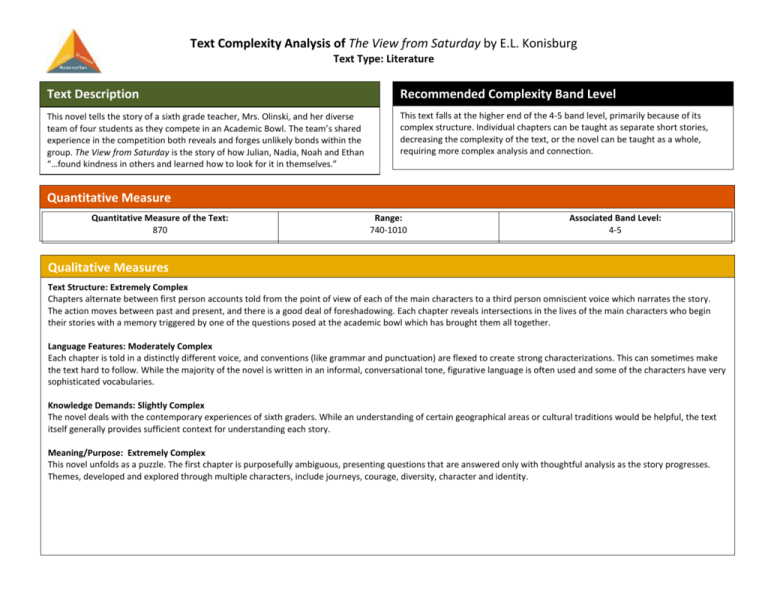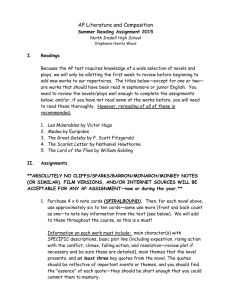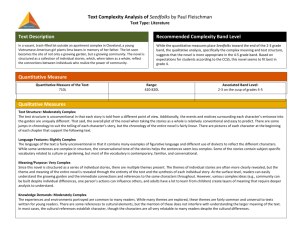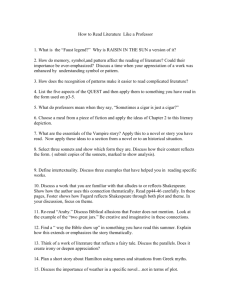The View from Saturday Text Complexity Analysis
advertisement

Text Complexity Analysis of The View from Saturday by E.L. Konisburg Text Type: Literature Text Description Recommended Complexity Band Level This novel tells the story of a sixth grade teacher, Mrs. Olinski, and her diverse team of four students as they compete in an Academic Bowl. The team’s shared experience in the competition both reveals and forges unlikely bonds within the group. The View from Saturday is the story of how Julian, Nadia, Noah and Ethan “…found kindness in others and learned how to look for it in themselves.” This text falls at the higher end of the 4-5 band level, primarily because of its complex structure. Individual chapters can be taught as separate short stories, decreasing the complexity of the text, or the novel can be taught as a whole, requiring more complex analysis and connection. Quantitative Measure Quantitative Measure of the Text: 870 Range: 740-1010 Associated Band Level: 4-5 Qualitative Measures Text Structure: Extremely Complex Chapters alternate between first person accounts told from the point of view of each of the main characters to a third person omniscient voice which narrates the story. The action moves between past and present, and there is a good deal of foreshadowing. Each chapter reveals intersections in the lives of the main characters who begin their stories with a memory triggered by one of the questions posed at the academic bowl which has brought them all together. Language Features: Moderately Complex Each chapter is told in a distinctly different voice, and conventions (like grammar and punctuation) are flexed to create strong characterizations. This can sometimes make the text hard to follow. While the majority of the novel is written in an informal, conversational tone, figurative language is often used and some of the characters have very sophisticated vocabularies. Knowledge Demands: Slightly Complex The novel deals with the contemporary experiences of sixth graders. While an understanding of certain geographical areas or cultural traditions would be helpful, the text itself generally provides sufficient context for understanding each story. Meaning/Purpose: Extremely Complex This novel unfolds as a puzzle. The first chapter is purposefully ambiguous, presenting questions that are answered only with thoughtful analysis as the story progresses. Themes, developed and explored through multiple characters, include journeys, courage, diversity, character and identity. Text Complexity Analysis of The View from Saturday by E.L. Konisburg Text Type: Literature Considerations for Reader and Task Major Instructional Areas of Focus (3-4 CCS Standards) for this Text: Below are factors to consider with respect to the reader and task: RL.4.2 - Determine a theme of a story, drama, or poem from details in the text; summarize the text. Potential Challenges this Text Poses: The structure of this text is atypical, but it does follow a regular pattern, which students will enjoy discovering. Teachers will likely need to introduce and explain some common literary techniques (like including the name of the speaker in the title of a chapter and the use of flashbacks) to support comprehension. Summarize and then compare the narratives told by each of the main characters. What larger theme might knit them together? RL.4.3 - Describe in depth a character, setting, or event in a story or drama, drawing on specific details in the text (e.g., a character’s thoughts, words, or actions). 4. W. 9. Draw evidence from literary or informational texts to support analysis, reflection, and research. Chose a single adjective to describe each main character. Collect evidence from the text that shows how the character demonstrates the trait chosen through his/her thoughts, words and actions. RL.4.6 - Compare and contrast the point of view from which different stories are narrated, including the difference between first- and third-person narrations. As each chapter begins, work to establish the point of view from which it is being told. What markers in the text signal that a story is being told in first person or in third person? Focus on events in the text told from different points of view, like the incident where someone wrote “cripple” on Mrs. Olinski’s chalkboard, how are the accounts similar or different? Why might that be? Discuss perspective and, after reading, consider why this book is entitled, The View from Saturday. W.4.2 - Write informative/explanatory texts to examine a topic and convey ideas and information clearly. At the end of the book, we learn that the members of the team had been chosen because “ all [have] returned from a journey”. Write an essay that briefly summarizes each character’s journey and reflect on their commonalities. At points, the text is intentionally ambiguous to provoke thought and encourage inquiry. Students need to be reassured that the uncertainty or confusion they feel at times is purposeful, and will be resolved through the continued close reading of the text. It may be helpful to list questions that arise on a two column chart, adding the answers (or possible answers) in the second column as they become clear in the text. Changes in voice from chapter to chapter may be confusing. Reading the first page of each chapter aloud can help to establish patterns and rhythms that will set the stage for more fluent independent reading. Differentiation/Supports for Students: Present the book as a puzzle to be solved. Model approaching the story with excitement and the thrill of discovery to help students become comfortable with the process of shared inquiry into a piece of literature. Have students read out loud and reread frequently to better understand events and characterizations. Graphic organizers like character maps and flow charts can help students to understand and record the complex relationships between events and characters as they unfold in the book. Encourage students to approach the book on a variety of levels. The structural complexity will make even literal comprehension an accomplishment for some students; others will be ready to delve deeply into theme and author’s craft. Plan for, and acknowledge, the many types of learning that may arise as you work with each part of the text.











